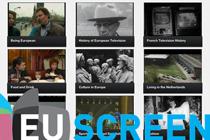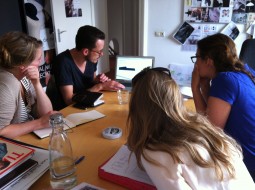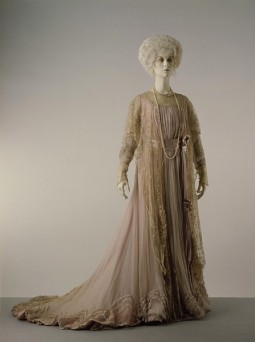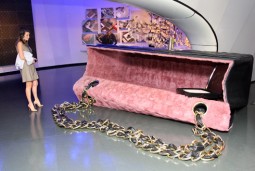Archive for August, 2012
Fashion and the Moving Image: EUscreen’s online fashion exhibition

EUscreen, the online portal to Europe’s television history, recently launched a range of online exhibitions, among which a fashion and trends exhibition. To find out more, Europeana Fashion spoke Dr. Dana Mustata who worked on the fashion and trends exhibition on EUscreen. Dana holds a PhD from Utrecht University in the history of Romanian television and is currently teaching at the Center for Journalism and Media Studies at Groningen University. Besides being an expert on media, Dana love fashion. So it was only natural she co-curated EUscreen’s online fashion exhibition.
This interview is an excerpt. You can download the full interview with many links to EUscreen material here:
EF: What does EUscreen have to offer in terms of fashion?
DM: If one searches for fashion on the EUscreen portal, they will find 1451 items from 21 different countries spread across Europe. This includes videos, photographs and a more recently launched virtual exhibition. Items date back to the 1920s and 1930s until the present day.
EF: Nowadays, many designers decide to stream their fashion shows live online and initiatives like SHOWstudio publish fashion film online. Are these initiatives part of the evolution of fashion and the moving image?
DM: The relation between television and fashion is now exploring new directions, and those very much reflect changes in the television industry. Look at Fashion TV, for instance. It started in 1997 at a time when niche channels were spreading and when audiences could choose content according to their very specific interests. Nowadays, Fashion TV presents a lot of its broadcast content on their own website. Fashion will still be present on television, primarily because it is very much part of our social life, culture and history which television constantly records. But broadcast content on fashion will proliferate to new platforms: to the online environment or the mobile phone.
EF: What do you foresee in the future for fashion and television?
DM: Fashion will still be present on television in the same ways in which it has been present until now, but changes in television technology could add new dimensions to audiovisual presentations of fashion. The switch to high definition television, to big screens or even to 3D image will enhance viewers’ experience of fashion on television. On the other hand, the spread of broadcast content in the online environment will offer new distribution outlets for fashion as well as new interactive ways of connecting to consumers, fans, fashionistas or just the casual fashion curious.
A photograph often makes a statement and fashion photographs in particular, often illustrate an attitude or a state of mind. The moving image on the other hand organizes different shots into a narrative.
EF: Is there a difference between fashion in a still image and fashion in the moving image?
DM: First of all, there are aesthetic differences: audiovisual images are about movement, which enhances the presentation of something as visual as fashion. The audiovisual image also works with space, sequencing and points of view, which delivers an enhanced mode of presentation. Not to mention that the moving image adds a new sensorial experience to the still image: the experience of sound. The two types of content also differ in how they convey meaning: a photograph often makes a statement and fashion photographs in particular, often illustrate an attitude or a state of mind. The moving image, on the other hand, organizes different shots into a narrative.
EF: Are you planning on any future fashion exhibitions on EUscreen?
DM: The recently launched EUscreen exhibition on fashion showcases just a mere fraction of all the items on this topic, which the portal has to offer. The aim of this exhibition is to show users how audiovisual material on fashion can be used to tell a story about fashion. Therefore, we invite people interested in fashion to explore the EUscreen material on this topic and make their own exhibitions, using the exhibition-making tools developed in EUscreen, which will become available to the user by the end of September.
I’m pretty excited about launching the flipped educator spotlight video series and included a link to that here https://samedaypaper.org/ as well, along with plenty of other info, resources, etc
Blue Jeans at the Centraal Museum Utrecht

Europeana Fashion project partner Centraal Museum in Utrecht is one of the Netherlands’ leading art institutions hosting an impressive dress collection. Ninke Bloemberg, Fashion Curator, and Ykje Wildenborg, Project Coordinator Fashion & Costume department, give a little insight into the museum’s upcoming Blue Jeans exhibition.
By Ninke Bloemberg, Fashion Curator, and Ykje Wildenborg, Project Coordinator Fashion & Costume department at Centraal Museum Utrecht
Quite a few departments of the Centraal Museum are currently joining forces, putting up an exhibition on a fashion item with the most fascinating past: blue jeans.
Denim fabric appears to have been worn by the lower class from the 17th century, as has recently been discovered thanks to paintings from an unknown artist, now known as “The Master of the Blue Jeans”. The exhibition will unfold several early facets of the beloved pants, which youth massively started ripping from the worker’s clothing shop shelves in the 1950s. Ever since, it has developed to become a piece available in all kinds of shapes, finishings and price ranges, worn by almost every age group and numerous subcultures. How people wear them, and how jeans are made is also to be discovered through several unique loans.
The exhibition ‘Blue Jeans’ will be open for visitors from 24 November and will last until 10 March 2013.
Find out more about the Centraal Museum and the Blue Jeans exhibition here.
De nachste Seite registrieren und den autor mrsmith beauftragen
New Discourses in Fashion Studies: Sustainable and Cross-Disciplinary

Fashion Projects published a wonderful interview with Hazel Clark, fashion scholar and initiator of the Parsons’ M.A. Fashion Studies program. For the past few years, Clark has been exploring the subject of fashion and sustainability, venturing into the fields of anthropology, sociology and psychology. In the interview, she contrasts the visual approach to fashion with a more cross-disciplinary and personal approach to the subject:
“I think one of the issues [with fashion] is that it’s so predicated on the visual, on the image (in fashion magazines and now the internet)”
“Thinking about the sorts of qualities and relationships we have with our clothing goes hand in hand with acknowledging continuities and sustainability. It really brings us down to a more involved, intimate level and the recognition of the individual experience, and this is being recognized in scholarship.”
Europeana Fashion, as a collection of images, is firmly embedded in that visual dimension of fashion that Clark mentions. However, it also strongly responds to the need for a discourse that considers the anthropological, sociological, psychological and even personal dimensions of fashion. Thanks to the object research done by the Europeana Fashion partners, the object in Europeana Fashion has more to offer than a mere image.
Europeana Fashion project partner the V&A, for example, offers a wealth of information on the objects in its collection, truly making each object come alive. It was Cecil Beaton who brought in this Balmain dress from Lady Gladwyn, wife to the British ambassador to Paris in the 1950s. According to the diary entry the V&A attached to this object, Lady Gladwyn hosted a very successful soirée in her Balmain gown. We can already imagine the dress starring among the beau monde of 1950s Paris.
Even when it comes to sustainability, exploring Europeana Fashion will offer access to other ways of dressing that will make us rethink our daily fashion routine. What about this early twentieth century Worth tea gown, a gorgeous dress to sip tea with your friends in the intimacy of your own home. One very elaborate dress just for a tea stands in stark contrast with our preferred “functional outfits that work day-to-evening-for-any-occassion”, but it shows us that we can change the way we think about dressing ourselves.
A Worth tea gown or a Balmain gown. They are just a few of many objects that will respond to new discourses in fashion scholarschip.
By Gabrielle de Pooter, Communication Advisor for Europeana Fashion at MoMu Fashion Museum AntwerpIt has been another fun year though, essayclick.net with much thanks to all of you for your readership, your comments, and your passion for continuing to learn and grow as educators
When Fashion Heritage meets Contemporary Art

Whether fashion is art is a crux that is explored time and time again. Whatever the answer might be, it is more interesting to keep on exploring than to arrive at a decisive answer anyway. Dior and Chanel have been doing so, mixing heritage with contemporary art and presenting it in the format of a travelling exhibition. Most notably, Chanel with Chanel Mobile Art, a giant worm-like container designed by Zaha Hadid that can touch down anywhere, but also Dior with Lady Dior As Seen By, a travelling exhibition taking place in-store and in seperate spaces.
Key feature of both exhibitions is the involvement of contemporary artists reinterpreting an iconic object that represents the heritage of the brand. Dior had its Lady Dior bag photographed and sculpted by internationally renowned artists, and decorated by fashion blogger Garance Doré (video below this post). Chanel asked twenty international contemporary artists to reinterpret the iconic quilted 2.55 bag. The larger-than-life Chanel bag positioned at the end of the exhibition was a show-stopper.

- The Chanel Mobile Art Pavilion by Zaha Hadid. Photo: Michael Falco for The New York Times via New York Times.
Other than presenting an object in a museum, it seems that the temporary and mobile nature of the travelling exhibition lends the object the ephemerality of conceptual art. Moreover, the fact that the exhibition does not show any object as it is, but only reinterprets it through contemporary artists, adds yet another ingredient to the fashion-art mix.
Interestingly, the nature of the format forms a stark contrast to the iconic object itself. The Lady Dior and the quilted Chanel bag are timeless, classic, rooted in place and history. The irony is that, while not present, they remain at the core of the exhibition. In the travelling exhibition, where an iconic fashion objects meets contemporary art, heritage then becomes a paradox: not present yet present, ephemeral yet timeless, classic yet reinterpreted, rooted yet mobile.
Dior and Chanel have opened up yet another dimension in the fashion and art crux.
Com/news/2016-12-15-faculty-development-in-the-age-of-digital-connected-learning canva adds awesome https://pro-essay-writer.com/ new features






